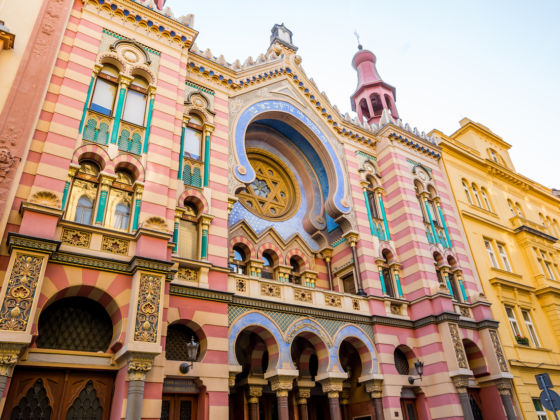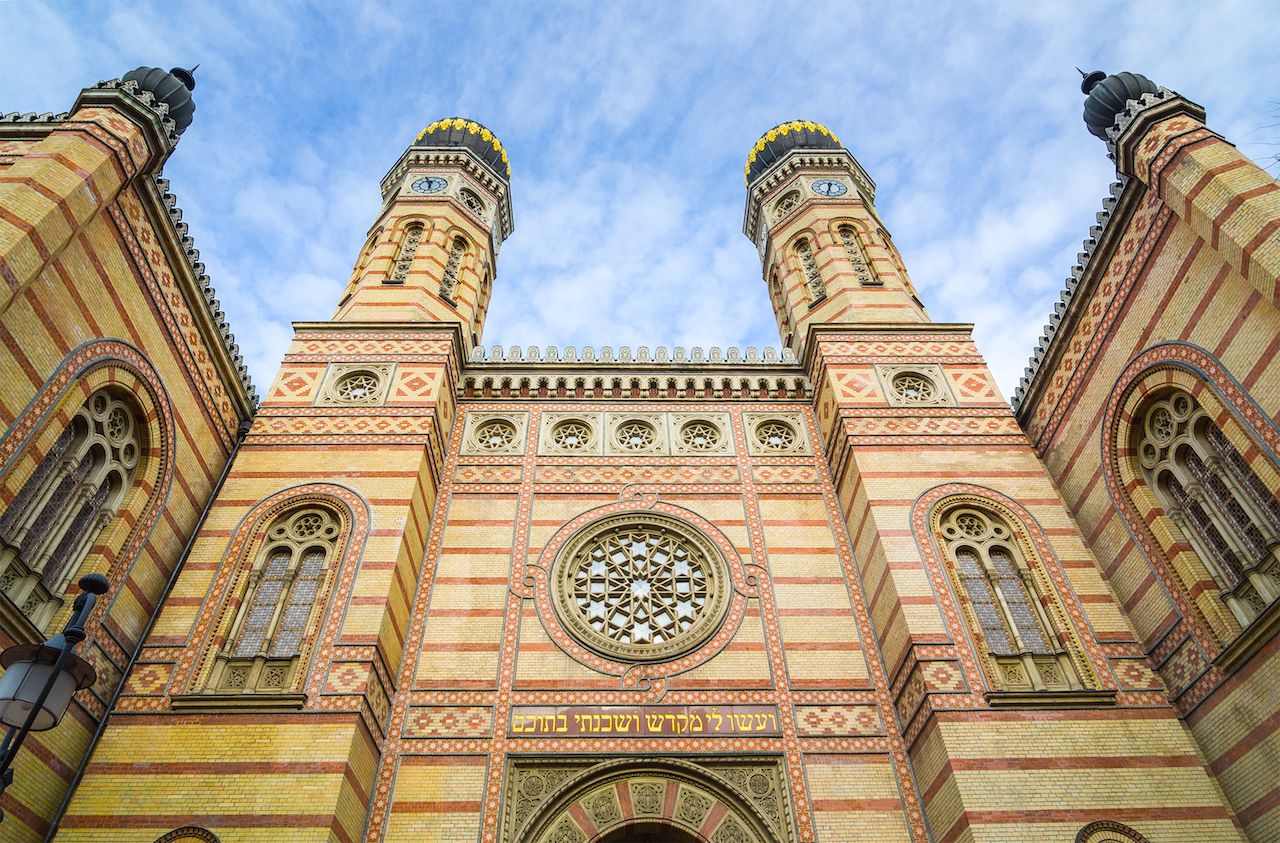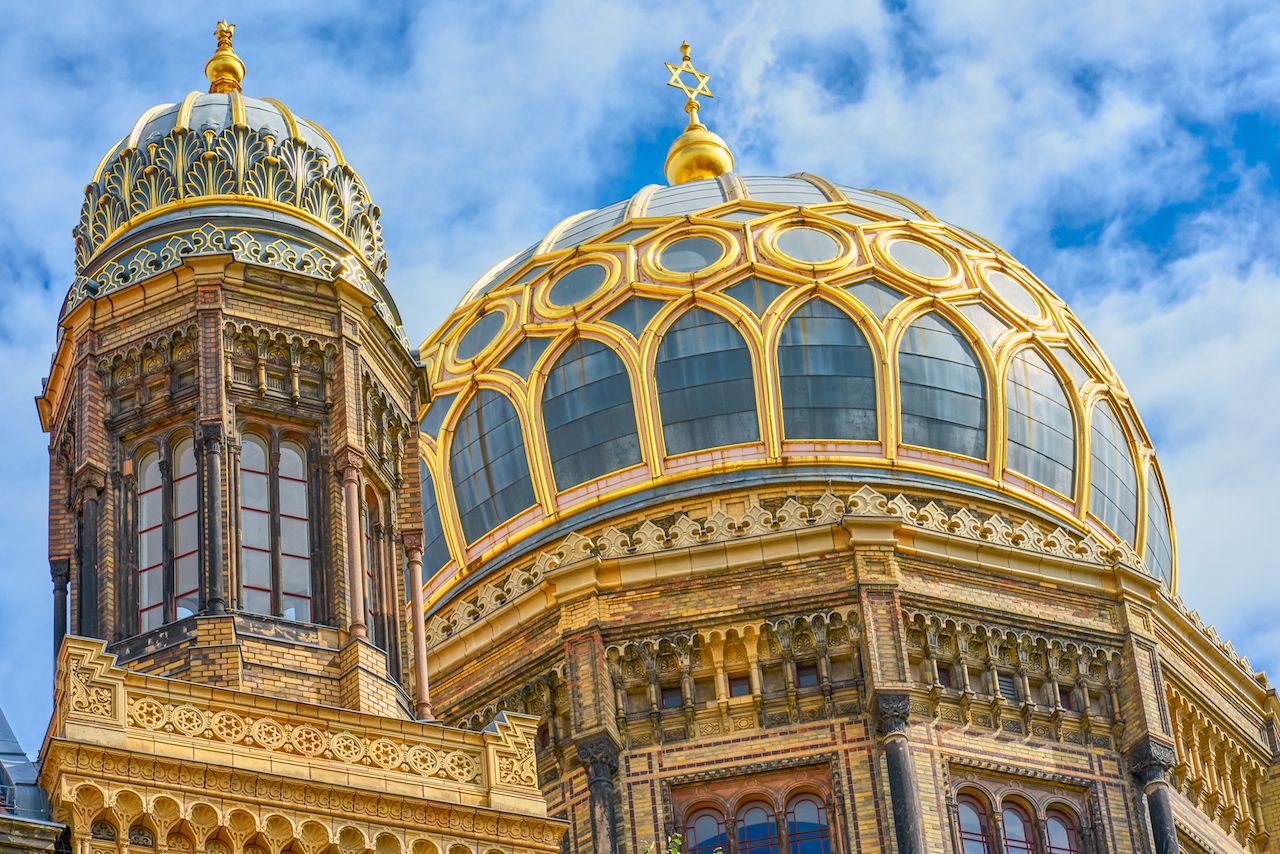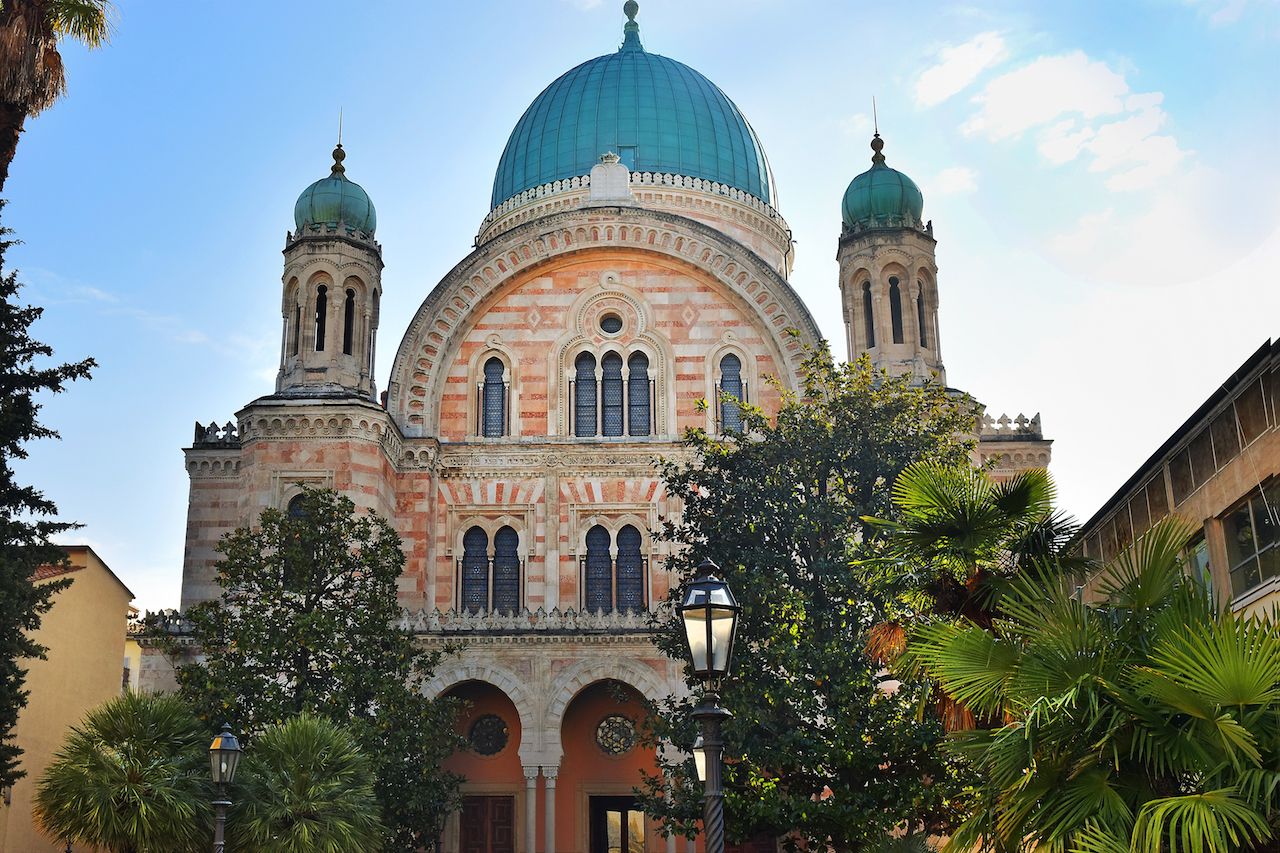Houses of worship represent some of the world’s most brilliant architecture. Religious monuments like Paris’s Notre-Dame Cathedral and Istanbul’s Blue Mosque attract millions of visitors every year, both as important cultural landmarks and active places of prayer. Fewer synagogues around the world are immediately recognizable though many are considered top attractions by the cities that host them. Here are seven breathtaking synagogues from around the world that you should definitely visit.

The 7 Most Amazing Synagogues From Around the World
Jubilee Synagogue, Czech Republic

Photo: Pres Panayotov/Shutterstock
Despite being sandwiched between banana-yellow and creamsicle-colored buildings, the Jubilee Synagogue is the only thing you see when you walk down Jerusalem Street. Its red-and-gold-striped facade is complemented by splashes of color, such as the periwinkle accent that surrounds the focal rosette window and Star of David. Wilhelm Stiassny designed the synagogue in 1906 in the Moorish Revival Style, adding Art Nouveau touches like vine motifs and wrought light fixtures. Stiassny named the holy site in honor of Emperor Franz Joseph I of Austria’s silver jubilee. Prague’s youngest synagogue, Jubilee synagogue is also one of the most important Jewish landmarks in Prague. It welcomes worshippers year-round and visitors every day, except Saturdays and Jewish holidays between April and October.
Subotica Synagogue, Serbia
Subotica, located near the Serbia-Hungary border, plays host to one of the few remaining examples of Hungarian Art Nouveau architecture on Earth. The Jakab and Komor Square/Subotica Synagogue is the creation of architects Dezső Jakab and Marcell Komor. It was built at the turn of the 20th century as a place of worship for Neologs, one of two predominant Hungarian Jewish communities, and named a Monument of Culture of Exceptional Importance in 1990. The synagogue’s brick-and-ceramic exterior is topped with a strikingly gilded dome, but the best view is on the inside, where you’ll find bright orange accents and a beautiful floral motif.
Great Synagogue, Hungary

Photo: Yury Dmitrienko/Shutterstock
Also called Dohány Street Synagogue, this massive Hungarian landmark is the largest synagogue in Europe and the second largest in the world. It holds a whopping 3,000 seats and sits smack dab in the heart of Budapest’s old Jewish quarter. Dohány Street bordered the Nazi ghetto during World War II, witnessing unspeakable tragedy, and the synagogue complex includes a cemetery, memorial park, museum, and Heroes’ Temple to commemorate the Hungarian Jews who lost their lives during the World Wars. Countless lighting fixtures hang from the high-vaulted ceiling and run overhead the pews, giving the interior a luminous quality that is magnified by the bright frescoes surrounding the Torah Ark.
Uzhgorod Synagogue, Ukraine
This synagogue in western Ukraine was built in 1904, when the region belonged to the Austro-Hungarian Empire. It blends design elements of the Moorish Revival and Byzantine Revival architectural movements as envisioned by architects Gyula Papp and Ferencz Szabolcs. Uzhgorod Synagogue doesn’t look like much compared to some of the other synagogues on this list, but it more than makes up for its appearance with its killer acoustics. The synagogue has been used as a local concert hall for decades and has proudly hosted the Regional Philharmonic Society with the Transcarpathian Folk Choir.
The New Synagogue, Berlin, Germany

Photo: Ugis Riba/Shutterstock
Established in 1866, this synagogue spent years at the epicenter of Jewish life in Berlin. It was the largest synagogue in Germany at the time it was built, designed to accommodate growing numbers of Eastern European immigrants, and its highly-anticipated inauguration was even blessed with Prime Minister Otto von Bismarck of Prussia’s presence. Sadly, the synagogue had been all but demolished by the end of World War II, sustaining particularly bad damage during “Kristallnacht,” during which fires were lit inside the synagogue and the Torah scrolls were defiled. Still, it was one of few Jewish temples to survive the pogrom at all. Though what we see today is a truncated reconstruction of the original, the towering Berlin Synagogue and its golden dome remain icons of German Jewish heritage.
The Great Synagogue of Florence, Italy

Photo: irisphoto1/Shutterstock
This spectacular synagogue is a grand display of copper domes, tall archways, and a sleek marble facade. Its design also borrows from Moorish and Sephardic traditions, and the interior is covered with elaborate frescoes and mosaics. But the synagogue lives up to its “great” name in more ways than just its appearance. It was an emblem of freedom when it was founded, shortly after the emancipation of the Jewish community post-Napoleonic occupation, and has been a haven for the city’s prolific Jewish populations since 1882. Tours of the synagogue — which saw major renovations after World War II and the 1966 flooding of the Arno River — are welcome every day except Saturday, as long as services are not being held.
Szeged Synagogue, Hungary

Photo: Judy Ben Joud/Shutterstock
Szeged Synagogue’s exterior will catch your eye as you pass by, but it isn’t until you step inside that you realize just how amazing this holy site is. Beneath its majestic domes and cupolas are lavish carvings, paintwork, and stained-glass windows that exemplify Renaissance- and Baroque-style opulence. Szeged Synagogue was completed in 1902 when city life was blossoming in Szeged and the local Jewish community was thriving. It’s way too beautiful to skip if you’re traveling through the area and stunning enough to merit a trip if you’re passing through southern Hungary in general. Stop by from Sunday to Friday between April and October to see for yourself.